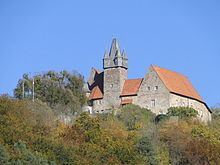Elevation 200-530 m (−1,540 ft) Area 97.7 km² Postal code 34286 Dialling code 05663 | District Schwalm-Eder-Kreis Time zone CET/CEST (UTC+1/+2) Population 6,281 (30 Jun 2009) Local time Wednesday 1:26 AM Administrative region Kassel | |
 | ||
Weather 8°C, Wind SW at 6 km/h, 79% Humidity | ||
Spangenberg is a small town in northeastern Hesse, Germany.
Contents
- Map of Spangenberg Germany
- Geography
- History
- Historic sights
- Coat of arms
- Constituent communities
- Partnerships
- Personalities who have worked on the ground
- References
Map of Spangenberg, Germany
Geography
Spangenberg lies in the Schwalm-Eder district some 35 km (22 mi) southeast of Kassel, west of the Stölzinger Gebirge, a low mountain range. Spangenberg is the demographic centrepoint of Germany.
History
The town of Spangenberg had its first documentary mention in 1261, at about the time when the Treffurt family ruled Spangenberg.
Historic sights
The town is known best of all for its Schloss Spangenberg, a castle built in 1253 and the town's landmark. Also worth seeing are the half-timbered buildings in the Old Town and the remains of the town's old wall, several of whose towers are still standing.
In World War II, Spangenberg Castle was used as a prisoner of war camp, Oflag IX-A/H.
Coat of arms
Spangenberg's civic coat of arms is based on the town's oldest known seal from 1317. The object on the viewer's right (heraldically speaking, the left, as the shield is considered from the point of view of the bearer) side is a kind of fossilized plant locally known as a Spange (also German for "brooch" or "clip"), the town's namesake. The item on the viewer's left (heraldic right) is half of a wheel. Wheels are common in German civic heraldry, usually indicating some connection to the Archbishopric of Mainz, whose arms include wheels in honor of St. Willigis. The current colours – red and gold – have been in use since 1621.
Constituent communities
In alphabetical order, these are Bergheim, Bischofferode, Elbersdorf, Herlefeld, Kaltenbach, Landefeld, Metzebach, Mörshausen, Nausis, Pfieffe, Schnellrode, Vockerode-Dinkelberg and Weidelbach.
Partnerships
Spangenberg maintains partnerships with the following places:
